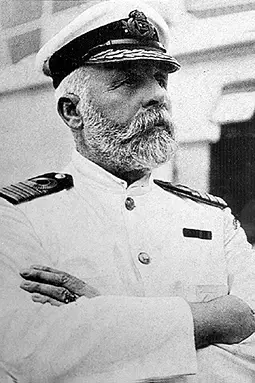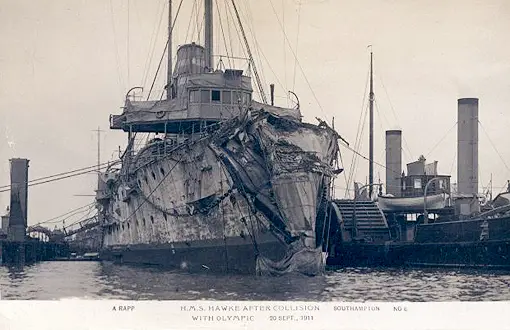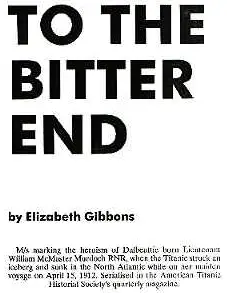9. The Hawke Collision
Captain Smith and speed were from June of 1911 to be the first intimations of impending tragedy. Olympic's two senior officers (Wilde and Murdoch) were used to Smith's instructions regarding speed, Murdoch having been with Smith at least since Adriatic's maiden voyage in 1907. Lightoller had served under Smith on the Majestic, and made a point in his memoirs of stressing the latter's ability to maneuver a ship at high speed through difficult coastal waters. Smith in conversation on the Adriatic in 1907 would admit fear only of fog. Fog intensified all hazards, and in particular it hid the icebergs. The inference is that so long as the way ahead was clear, there was no need to slow. This supposition is reinforced by his discussion with Lightoller on the bridge of the Titanic on April 14th, slightly less than 90 minutes before the collision:
Senator Smith: Was any reference made at that time to the wireless message from the Amerika?
Mr. Lightoller: Capt. Smith made a remark that if it was in a slight degree hazy there would be no doubt we should have to go very slowly. (Page 67)

Captin E J Smith.
There is no reason whatsoever to believe that slowing down was an idea that came naturally to E. J. Smith, and his habits of command, so typical of the Western Mailboat tradition, led in late 1911 to misgivings at White Star headquarters, illuminated in a letter written to J. Bruce Ismay on August 1, 1912, by solicitor Frederick Radcliffe. Ismay's presence on Titanic was alleged to have encouraged tendencies to seek a record crossing, and to refute this Ismay wished the public to know that he was adamant regarding safety. While Ismay's letter seems to have disappeared, the itemized response from Radcliffe refers to the pre-Titanic collision between the Olympic and H. M.S. Hawke as a particularly unwise subject on which to issue statements regarding company policy on speed. E. J. Smith had captained both Olympic and Titanic, Radcliffe wrote, stating that Ismay as Chairman was the responsible party and that if he had felt Smith should be instructed to slow down but allowed others in the company to overrule him for what Radcliffe discreetly termed "business reasons", his would be the culpability. There was no evidence, Radcliffe pointed out, that Smith knew of this "difference" at headquarters, but if he did, he knew also that Ismay had elected to do nothing about it. Whether or not Ismay grasped the legal implications of his solicitor's elegant circumlocutions, he did take the advice: keep quiet.
The "difference" at headquarters over orders to its captains was a consequence of the collision on September 20, 1911, between Olympic and H.M.S. Hawke just outside Southampton harbor, in clear autumn weather, as the Olympic started toward France on her regular run to New York. The cruiser Hawke, seemly inexplicably, had crashed into the Olympic's starboard side, opening two water tight compartments. A Naval Court of Inquiry cleared the Hawke of fault, and in December, 1911, an Admiralty Court ruled the Olympic solely responsible. White Star officials complained publicly, but apparently privately debated Captain Smith and his methods of command. Whatever the nature of the discussion, the result was a public show of continued confidence in Captain Smith. He remained in command of Olympic.
Senator Smith: Did the collision which occurred between the Olympic and the Hawk [sic] in any way shake your confidence in Capt. Smith?
Mr. Ismay: No, sir.
Senator Smith: If it had, he would probably not have been appointed as commander of the Titanic?
Mr. Ismay: Quite true." (Page 957) (What else, at this point, could Ismay say?)
Nevertheless, despite qualms, however tentative, at company headquarters over Smith's choice of cruising speeds, Smith himself had none; nor, apparently, did Murdoch or Lightoller. None of them was a mathematician or physicist, and until the 1911 Olympic Hawke collision, nobody who was had had cause to investigate the difficulties presented by the combination of size and speed in the new Olympic Class of oceanliner. Smith's only known reaction to the Admiralty finding was outrage at fault being assigned to his ship (which was under compulsory pilotage at the time), and on Christmas Eve, 1911, all of Olympic's officers signed a protest petition, asserting that the Court had disregarded their evidence.
The unanimous opinion of Olympic's officers was that the Hawke had carelessly struck them; the opinion of the professors (mocked in a marine engineering journal) that the enormous Olympic had by a sudden increase in speed pulled the far smaller Hawke into her starboard side was incomprehensible to all of them because it ran counter to their experience. But their years of experience were becoming ever less reliable with the leap from the ships of the 1890s to the four block long, 45,000 ton liners they were now expected to control, and was further undermined by the trust they placed in Harland & Wolff. So well built were the ships provided White Star that lengthy sea trials were brushed aside as superfluous: Olympic's trials were perfunctory, and Titanic's lasted only one day. Their very experience now, in fact, worked against them. Beginning with the Olympic Hawke hearing, the first glimmerings can be detected in Smith and Murdoch of a fatal turn of mind, the I know what I am doing syndrome of the expert.
The original transcript of the Admiralty Court hearing into the Olympic Hawke collision fills four boxes in the Public Record Office. Of this massive material, Murdoch's testimony consists of five pages. He appeared on November 17, 1911, and could not have been under examination for more than twenty minutes. His manner formal, cool, and guarded, Murdoch clearly shared the company view of Navy culpability, because of or in spite of the Royal Navy review clearing the Hawke, and his evidence while precise was unhelpful.
Examination in chief, by Mr. Laing:
1070. Q. Are you the first officer of the 'Olympic'? A. I am.
1071. Q. Do you hold an extra master's certificate? A. Yes.
1072. Q. Are you a lieutenant in the Royal Naval Reserve? A. Yes.
1073. Q. Was it your station to be on the poop? A. On the after end of the ship.
. . . . .
1075. Q. What drew your attention, if anything drew it, to the 'Hawke'? A. Two short blasts were sounded on our own steam whistle, and naturally I looked to see what it was for.
1076. Q. What did you see? A. I saw the cruiser coming along the starboard bow then.
. . . . .
1085. Q. Did anything attract your attention while you were on the boat deck? A. A few minutes afterwards, I saw the cruiser coming up almost parallel to our course.
1086. Q. On which side of you? A. On the starboard side.
1087. Q. Did you judge at all, or could you judge how far laterally she was passing you? A. About 1,000 feet I should think.
1088. Q. Was anything done at all on your ship with reference to the Hawke when you saw her? A. I am not responsible for the navigation on this particular part of the ship.
1089. Q. I am not referring to the navigation, was anything done on that part of the ship? A. Our ensign was dipped.
. . . . .
1094. Q. Did you see the collision, at all, yourself? A. I did not see the collision.
Cross examination by Mr. Bateson:
1095. Q. You know very little about it apparently? A. I have said all I know about it.
1096. Q. What were you doing aft on the poop? A. The after end of the ship.
1097. Q. What were you doing, anything or nothing? A. There are many duties to attend to.
1098. Q. Such as? A. Well, I have to see that everything is secured ready for sea after the ship is undocked and see that everything is below that is intended to go below, also to attend to the after telephone and telegraph.
1099. Q. You have got a good deal to do? A. Yes.
1100. Q. The first you saw of the 'Hawke' was when you were swinging under starboard helm? A. Yes.
1101. Q. And heard the two blasts? A. After I heard the two blasts.
.....
1108. Q. And then at some time or other you see her, you think 3 points on your starboard quarter? A. 3 points on the starboard quarter.
1109. Q. Is that very shortly before the collision? A. That would be probably 5 minutes, 5 to 6 minutes. I could not judge the time exactly. I should say 5 to 6 minutes.
. . . . .
1116. Q. You told us you saw her 1,000 feet off you? A. Yes, when she was about parallel to our course, steaming on the starboard side.
. . . . .
1133. Q. 1,000 feet from you a little over 300 yards in the position in which you have given us, if the Hawke starboarded her helm she could not catch you, could she? A. That is questionable.
. . . . .
1138. Q. How far had you traveled, do you think, from that point until the time of the collision? A. I could not tell you.
1139. Q. You talk about 5 minutes this vessel of yours was going at least a quarter of a mile a minute.
Murdoch was far too clever to respond to this last and was permitted to stand down; his manner of answering in as few words as possible indicates he had absorbed counsel's standard instruction not to say more than absolutely necessary and never to volunteer information. Devotees of the British Notable Trial series will recognize in Murdoch's exchange with Mr. Bateson a demonstration of the articulate hostile witness.

HMS Hawke
The tone of Murdoch's testimony is consistent with his belief that blame lay with the Navy, but, with the hindsight of events in 1912, there is one item of acute interest: Murdoch, extremely busy on Olympic's stern and boatdeck, not involved in navigation, nevertheless instantly reacted to the ship's steam whistle. Two blasts in inland water meant a port turn, and a port turn down the channel was not outside routine; nevertheless, in his own words, he "looked to see what it was for". This automatic reaction of the well trained officer is a point to remember when deciphering what happened on Titanic's bridge on April 14, 1912.
Olympic's collision damage was repaired at the Harland & Wolff yards in Belfast, and on November 19, 1911, the ship returned to the Atlantic route, Captain Bertram Hayes assuming command while Captain Smith and his officers testified before the Admiralty Court. Murdoch rejoined Olympic for her December 19, 1911, New York departure, having spent nearly three months ashore, with what inner frustration may be imagined. At this point, all trace of William Murdoch vanishes from the official Captains' Register; the 1912 records for his section under "M" are missing. He remained, however, on the Olympic and was her First Officer when she struck a sunken wreck, three days out of New York, breaking a propeller blade; she limped into Plymouth on February 27, 1912, and left for repair yet again on February 28, 1912. On March 4, 1912, while leaving Belfast, she struck bottom, this time escaping damage. While the sunken wreck might in the pre radar era be deemed a natural hazard, bottoming out in Belfast, like colliding with the Hawke, should have been a warning that confidence in maneuvering the new great liners was unwise: practice shots by the Fates.
